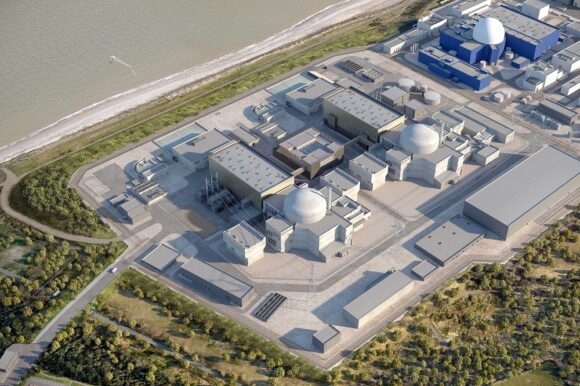
By UK Government-Wikipedia
The projected cost of building the Sizewell C nuclear power plant in Suffolk has surged to £38bn—almost double previous estimates—and is expected to add approximately £1 a month to household energy bills for at least the next decade.
The earlier official estimate for the project stood at £20bn. However, Julia Pyke, joint managing director of the plant, stated that the initial figure did not fully account for inflation or construction-related risks. The updated cost comes as the UK government confirmed on Tuesday that it will take a 44.9% stake in the development, alongside securing private sector investments from several companies, including Centrica, the parent firm of British Gas.
Sizewell C is projected to begin operations in the mid to late 2030s. Once operational, Pyke estimates that the plant could reduce household energy bills by a total of £2bn annually. She clarified that during the plant’s construction phase, the cost to consumers would be approximately £1 per month—accumulating into a modest annual charge over the coming years.
The investment consortium includes EDF, La Caisse de dépôt et placement du Québec (La Caisse), Centrica, and Amber Infrastructure. In exchange for their funding, these stakeholders will share in the plant’s ownership, which is distributed as follows:
- UK government: 44.9%
- La Caisse: 20%
- Centrica: 15%
- EDF: 12.5%
- Amber Infrastructure: 7.6%
Alison Downes, director of the environmental advocacy group Stop Sizewell C, sharply criticised the project’s financial structure. “It is astounding that it is only now, as contracts are being signed, that the government has confessed that Sizewell C’s cost has almost doubled to an eye-watering £38bn—a figure that will only go up,” she said. “The project has only crawled over the line thanks to guarantees that the public purse, not private investors, will carry the can for the inevitable cost overruns.”
Conversely, Tom Greatrex, chief executive of the Nuclear Industry Association, defended the scale of the investment. He said the spending was “money well spent” and highlighted the project’s potential to generate “thousands upon thousands of good jobs.”
Julia Pyke emphasized that Sizewell C’s design is “85% copied” from Hinkley Point C in Somerset, which she argued would help reduce both construction time and costs. Hinkley Point C—currently the UK’s only new nuclear power plant under construction—was initially estimated to cost £18bn and be completed by 2017. It is now not expected to be completed for another four to six years and has seen its budget rise to £46bn, partly due to pandemic-related delays.
Greatrex called Sizewell C the first “true replica nuclear power station” and said it demonstrates the effectiveness of repeating proven designs to reduce costs and build times. “This is the best way to build faster and cheaper, and we must apply those lessons to a full programme,” he said.
The Treasury noted that Sizewell C is expected to generate enough electricity to power six million homes and create 10,000 direct jobs, with thousands more in associated industries and supply chains.
Energy Secretary Ed Miliband hailed the project as a milestone in revitalising Britain’s infrastructure ambitions. “It is time to do big things and build big projects in this country again,” he said. “Today we announce an investment that will provide clean, homegrown power to millions of homes for generations to come.”
This investment also marks the first nuclear energy commitment from the government’s National Wealth Fund, which will act as the principal investor and policy bank supporting the initiative.
Chancellor Rachel Reeves welcomed the multi-billion-pound commitments from La Caisse, Centrica, and Amber Infrastructure, calling them a “powerful endorsement” of the UK’s positioning as “a global hub for nuclear energy.”
Despite the UK’s rich nuclear legacy—including the establishment of the world’s first commercial nuclear power station in the 1950s—the country has not opened a new nuclear plant since 1995. With the exception of Sizewell B, all of the UK’s existing nuclear fleet is expected to be decommissioned by the early 2030s.
Sizewell C was originally identified in 2009 as one of eight potential nuclear sites by then-Energy Secretary Ed Miliband. However, the project languished without full funding for over 14 years under successive governments before finally securing the necessary financial backing under the current administration.




